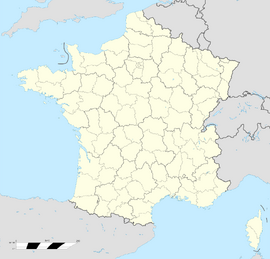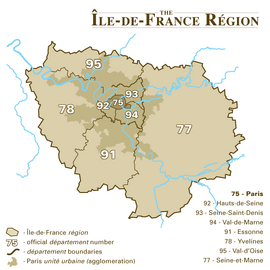| Main | Births etc |
|---|
| Dourdan | |
|---|---|
| Coordinates: Coordinates: | |
| Country | France |
| Region | Île-de-France |
| Department | Essonne |
| Arrondissement | Étampes |
| Intercommunality | Le Dourdannais en Hurepoix |
| Government | |
| • Mayor (2008–2014) | Olivier Legois (PR) |
| Area1 | 30.64 km2 (11.83 sq mi) |
| Population (2006)2 | 9,602 |
| • Density | 310/km2 (810/sq mi) |
| INSEE/Postal code | 91223 / 91150 |
| Elevation | 87–103 m (285–338 ft) (avg. 95 m or 312 ft) |
| 1 French Land Register data, which excludes lakes, ponds, glaciers > 1 km² (0.386 sq mi or 247 acres) and river estuaries. 2 Population without double counting: residents of multiple communes (e.g., students and military personnel) only counted once. | |
Dourdan is a commune in the Essonne department in Île-de-France in northern France.
It is located in the metropolitan area of Paris.
Geography[]
Dourdan is located on the river Orge in the western Essonne. The town is surrounded by the Dourdan's forest (Forêt de Dourdan).
Inhabitants of Dourdan are known as Dourdannais.
History[]
The origin of the name comes credibly from "Dour" derived of the Celtic root "Dor" which means "water" or "river", the same origin as for the English city of Dover. The radical "dan" could have meant "hill". Dourdan (Dordincum) developed during the Gallo-Roman period as an important center of production of ceramics. In the Middle Ages, it became the residence of Hugh the Great, father of Hugh Capet; he died there in 956.
Dourdan became a royal city in 987, when Hugh Capet was crowned king.
In 1220, King Philip II Augustus of France built a new castle; its most famous owners were: Blanche de Castille, Louis d'Évreux, Jean, duc de Berry, François de Lorraine, duc de Guise, Maximilien de Béthune, duc de Sully, Anne of Austria and the House of Orléans.
Transportation[]
Two train and RER stations are located in Dourdan: Dourdan and Dourdan-la-Forêt, terminus of one of the branches of the "RER C" line.
The Dourdan SNCF station is on the line going from Paris Gare d'Austerlitz to Vendôme and Châteaudun.
Both stations allow passengers to go to Paris and Versailles, with trains leaving every 30 minutes.
Main sights[]
Saint-Germain-d'Auxerre Church[]
Construction of the church began in 1150 and was completed by the end of the 12th century. In 1428, during the Hundred Years' War, its upper part was badly damaged by the troops of the Earl of Salisbury, and it was not restored before the end of the 15th century. It was again damaged by the Huguenots during the Wars of Religion (1562–1598). In 1641, the asymmetric spires were constructed and, in 1689, the chapel dedicated to the Virgin Mary (chapelle de la Vierge) was built, increasing the length of the building from 36 to 50 metres. During the French Revolution of 1789, the church was again damaged. It was turned into a Temple of Reason (Temple de la Raison victorieuse), and also a prison until 1795.
Castle[]
Built at the request of Philip II Augustus at the beginning of the 13th century in the place of a wooden fortress, it is characteristic of the military architecture of this period. The castle is built on a square pattern, with towers at three of the corners and an isolated donjon at the fourth. The walls are punctuated by towers in the middle of each side, and two, on the east side, flank the gate. A deep stone-lined dry moat follows the outline of the castle. The donjon, the major defensive component of the castle, measures approximately 30 metres in height and 13.6 metres in diameter. It is the typical of the donjons being built by Philip Augustus at this time (e.g. Rouen), and by French nobility through the 13th century.

The donjon separated from the castle by its own ditch
The conception of the geometric pattern and isolated donjon was similar to that of the castle of the Louvre. A near identical castle is found at Seringes-et-Nesles, Aisne.
The castle became the property of Jean de Berry in 1385. There was a siege during the French Wars of Religion, stables were built in this period. Some figures who spent some time there include Jeanne II, Countess of Burgundy, and La Hire, friend of Joan of Arc.
The donjon was still a royal prison during the 17th century. There is a museum of local history.
The market hall[]
It was built in 1836 and is located in the downtown. It replaced the former hall from the thirteenth century. There is a floor to remind the former hall. The architect was Lucien-Tirte van Clemputte.

Townhall in front of François Mitterrand park.
Around Dourdan[]
The Royal forest of Dourdan[]
This is an old Royal forest where the kings of France used to hunt, covering a surface of 17 square kilometres. The forest is divided in 2 by the Orge river. The northern part is called forest of Saint-Arnoult while the southern part is the Ouÿe Forest (the name comes from a nearby abbey).
English Speaking Expatriates[]
Banlieue towns of the Île de France tend to depend a lot on Paris for administration purposes and other facilities. The centre of Paris is also a haven for several English speaking nationalities and EU expatriates, however in outlying towns such as this one there isn't the network that caters for these groups.
Twin towns[]
Dourdan has four twin towns:
 Bad Wiessee, Germany, since 1963
Bad Wiessee, Germany, since 1963 Troungoumbé, Mali, since 1988
Troungoumbé, Mali, since 1988Lac-Megantic, Quebec, Canada, since 1989
Great Dunmow, United Kingdom, since 1991
See also[]
- Communes of the Essonne department
References[]
- INSEE
- Mayors of Essonne Association (French)
External links[]
- Dourdan city council website (French)
- Pictures and History (French)
- Mérimée database - Cultural heritage (French)
- Land use (IAURIF) (English)
Template:Essonne communes
| This page uses content from the English language Wikipedia. The original content was at Dourdan. The list of authors can be seen in the page history. As with this Familypedia wiki, the content of Wikipedia is available under the Creative Commons License. |



